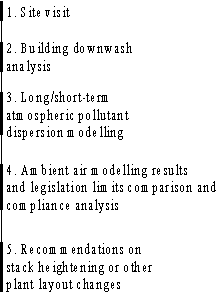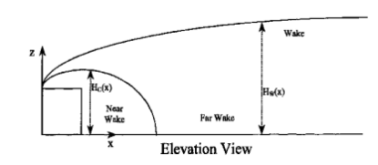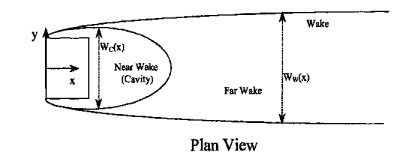
 |
||
| Scientists' Contributions | ||
THE IMPORTANCE OF BUILDING DOWNWASH IN ASSESSING THE NEED TO
HEIGHTEN STACKS OF EXISTING SMALL AND MEDIUM SIZED INDUSTRIES
João F. P. Gomes1, Rogério Duarte2
1Centro de Tecnologias Ambientais, ISQ ¾ Instituto de Soldadura e Qualidade, Oeiras, Portugal (jpgomes@isq.pt)
2Escola Superior de Tecnologia ¾ Instituto Politécnico de Setúbal, Setúbal, Portugal
1. INTRODUCTION
Atmospheric pollutant dispersal is a complex phenomenon that requires the use and interconnection between several distinct sciences. It is questionable that any simple set of rules can be used to assess the risk that certain specific emissions of atmospheric pollutants will cause on the environment, nevertheless, it is through the use of a simple - and cleaver - set of rules that most countries enforce the implementation of a “regulatory model” for the maintenance of acceptable ambient air quality. Portugal is no exception and since 1990 an Air Act exists establishing the basic principles of Portuguese air control and monitoring. Despite the tight interconnection that exists between pollutant emission flow, stack height and location, on one hand; and pollutant ambient air concentration, on the other hand, the regulatory model implemented in Portugal - see Gomes (2004) for details on the Portuguese air quality regulation policy - sets-up independent limits for maximum ambient air pollutant concentrations along with limits for maximum pollutant flow emissions, and also limits for minimum stack height. This methodology points into two directions that operators should follow regarding ambient air control, and often force them to take actions conducing to process chances (in order to reduce pollutant emissions) and/or stack heightening. From an environmental point of view, the reduction of pollutant emissions should be the preferred way to achieve ambient pollution abatement; in many cases, however, economic reasons dictate a compromise solution and frequently stack heightening is used as a way of “improving” ambient air quality. In Portugal, since the introduction of the Air Act in 1990, several existing operators had to review their stack height. The recent revision of Portuguese ambient air pollutant limits, which imposes stricter limits, and a growing social awareness on ambient air pollution issues contribute also to an increase in the number of operators that may have to review their stacks height. Instituto de Soldadura e Qualidade (ISQ), an accredited laboratory which analyses the compliance of pollutant emissions and monitors ambient air pollutant concentrations, has also a vast experience on stack height evaluation that spans back to 1986. Over 30 studies on the need to heighten stacks have been performed based on the use of a (long/short-term) Gaussian model and building downwash considerations.
This extended abstract intends to share the authors experience on the modelling of atmospheric pollutant dispersal and on the importance of building downwash considerations when assessing the need to heighten stacks of small and medium sized industrial enterprises (SME’s). In order to understand the reasons that make industrial companies, especially SME’s, consider stack heightening, in section 2 the existing Portuguese legislation on air quality and the stack heightening rules are briefly commented. New legislation that ought to appear soon (new Portuguese Air Act) is also commented and compared critically with the existing one. Then, section 3 characterizes Portuguese industry in terms of the ambient quality problems related to stack height. The adequacy of the stack heightening legislation to the particularities of the Portuguese case is discussed. In section 4 the authors experience in the specific study of stack heightening is presented. The methodology considered in these studies is discussed and compared with the application of existing and soon to appear legislation on stack height calculation. Finally, section 5 presents the conclusions and the need for an increased awareness on the pollutant dispersal problem is discussed.
2. PORTUGUESE AIR QUALITY LEGISLATION: A BRIEF OVERVIEW
The 1990 Portuguese Air Act established the basic principles of Portuguese air control and monitoring. From the beginning three concomitant fields subject to control were established: (i) ambient air pollutant concentration, (ii) pollutant flow emissions, and (iii) stack height.
Regarding ambient air, the adopted pollutant concentration limits were the ones adopted by the European Union at the beginning of the 1990, which were transposed into Portuguese law from the respective European Directives. Both air limits and recommended values for total suspended particulate, sulphur dioxide, nitrogen dioxide, lead and carbon monoxide were considered, however, these values were enforced only in 1993, due to a disagreement between the Portuguese authorities on the environment on one hand, and on the industry on the other hand. As in the correspondent European Directives, the main criteria for adopting ambient air pollutant limits was public health protection, and a monitoring system was introduced so that compliance with these values could be evaluated and measures could be derived afterwards. An Air Quality National Network was established for monitoring these pollutants in a series of stations, encompassing critical areas in term of ambient air quality and rural areas. Since 2002 a revision of the ambient air limits was introduced. This revision considered the adoption of new and stricter ambient pollutant concentration limits, deriving from the current European values, for pollutants such as PM10, PM2.5, sulphur dioxide, nitrogen oxides, carbon monoxide, ozone and benzene. Regarding emissions from stationary sources, and according to the 1990 Air Act, pollutant emissions to the atmosphere are subject to specific limits, according to the specific industrial sector and specific emitting source. For non-specified facilities general emission limits must be used. Although these principles were described in 1990, for the same reason stated above for ambient air, the emission limits were only issued in 1993. They included the European emission limits already published for incinerators and large combustion units, and also other limits specific to the Portuguese industrial units. As the emission limits fixed in 1993 resulted both from the measured values of the emission inventory on the Portuguese industry and also the best available technologies at that time, it is quite understandable that a revision of these emission limits urges, as the situation has considerably changed since then. Also the need to adopt, in Portugal, the new European Directives issued since 1993 on air quality forced the publication of other laws and regulations, such as specific limits regarding VOC emissions, emissions from large combustion units, and alterations on the monitoring and management system for ambient air.
Nowadays, the Portuguese legislation on air quality is dispersed among a series of laws and regulations and will be soon subject to a revision, resulting in a new air act. This revision will consider: (i) new emission limits for particulate, sulphur dioxide and nitrogen oxides, deriving from the European limit values already defined for large combustion facilities, (ii) new emission limits for specific pollutants, applicable to the Portuguese industrial units, resulting from a revision of the previous emission limits issued in 1993, and (iii) new methodologies regarding self control monitoring and reporting procedures for operators. In this revision special attention will also be given to air quality in critical areas.
Regarding stack height, it’s calculation was ruled in 1990 Air Act. A minimum height of 10 meters was specified and the following formula should be used whenever nearby buildings/structures were present,
where Ac stands for the stack height measured above soil (m), a stands for the nearby building/structure height measured above soil (m) and l stands for the smallest dimension (height or width) of the nearby building/structure (m). This calculation can only be overridden if specific technical studies were presented and approved.
Until now no other regulation has been issued, despite the fact that with the issuing of the new Portuguese Air Act (in preparation) this methodology will be altered and a new one inspired on the French regulations will be used. Regarding the existing stack height computation method described above, the following can be said. It doesn’t take into consideration pollutant flow volume, upward thermal forces, background pollutant concentration and presents a quite crude way of dealing with the presence of buildings/structures near the stacks. Comparing this method with the new methodology (to appear in Portuguese legislation), which takes into account pollutant flow volume, upward thermal forces and pollutant background concentration, and improves/clarifies the way nearby buildings/structures should alter stack height, a significant improvement towards a better stack height calculation can be expected.
3. CHARACTERIZATION OF THE PORTUGUESE INDUSTRY SECTOR: STACK HEIGHT RELATED PROBLEMS
A way of studying the Portuguese industry that is specially useful for relating atmospheric pollutant emission problems to stack height is one that considers the division between large and small to medium sized industrial enterprises, being the later SME’s those with less than 50 workers. For large industry, and regarding atmospheric pollutant emissions, it can be said that the implementation of the Air Act and of the related monitoring mechanisms has had a very beneficial effect on the lowering of pollutant emissions. This success is, however, more difficult to assess regarding stack height.
In the authors opinion, except for few very large industry plants (e.g., thermoelectric, incinerator or cement plants) where very tall stacks conform with the legislation, in general, the stack height of Portuguese industrial facilities doesn’t conform with legislation as stated in expression (1). This is usually due to the plant layout where large buildings/structures are commonly adjacent to the stacks. As a consequence, expression (1) results in very tall stacks. These common non-equilibrated results produces, in common practice, a generalized discredit of the 1990 Air Act stack height computation for most industrial plants. In some cases, enterprises decide to support stack height calculations based on technical studies rather than the legislation. Problems remain, however, when downwash isn’t correctly assessed, especially when poor plant lay-out planning results in complex roof geometry and a great number of stacks dispersed throughout the plant site. Regarding SME’s, the success brought by the Air Act to the pollutant emissions abatement is more questionable and this can be attributed, in part, to a generalized lower technical and human resources capabilities when comparing SME’s and large industrial enterprises. According to Gomes (2004), who analysed the pollutant emission compliance of about 400 sources belonging to Portuguese SME’s and large industrial facilities, it was found that compliance was higher in larger facilities, despite a significantly larger volume flow of atmospheric releases. This result is somehow disturbing if it’s taken in to account that the majority of the Portuguese industry sector is composed of SME’s. The fact that expression (1) doesn’t take in to account the pollutant flow emission makes its implementation even more difficult to support in SME’s, that can emit very small pollutant flow volumes. The disproportionate heights that can be attained with the use of expression (1), along with the limited compliance verification actions by the competent governmental bodies, results in an actual risk of high pollutant concentration at soil level, due to disrespect of minimum stack heights and non-consideration of downwash effects.
Another problem which has emerged in the later years is related with the demographic growth around Portuguese main cities and the consequent approximation of residential areas to traditional industrialised areas. The disrespect for urban planning has resulted in the construction of multi-storey buildings near several pollutant emitting industrial facilities.
It can be concluded therefore, in regard to stack height, the need for a revision of the current legislation that introduces adequate stack height calculation rules and a more efficient enforcement of the existing legislation. Regarding this last subject, it could also be useful to invest in pedagogy of the atmospheric pollutant dispersal problem near industry and non environmental related governmental and municipal institutions.
4. ATMOSPHERIC POLLUTANT DISPERSION MODELLING: THE AUTHORS EXPERIENCE
Experience in atmospheric pollutant dispersion modelling applied to over 30 Portuguese industrial facilities has been gathered by the authors since 1986. The great majority of these studies result from the need to assess, given certain pollutant emission values, stack height compliance with ambient air quality legislation. There are, however, some cases where the study results from actual complaints of nearby population or workers of the facilities. The methodology followed in the studies of atmospheric dispersion is presented in the flowchart of Figure 1.

Figure 1. Methodology used in atmospheric pollutant dispersion studies.
The methodology presented in Figure 1 starts with a site visit. This is a very important step, since it enables to gather information not only of the geometry and pollutant emissions, but also of the way workers understand atmospheric pollutant dispersal. Often, there is a generalized lack of understanding of the mechanics of pollutant dispersal and pollutant trapping in building or other structures wakes. With informal and simple conversations with the facility staff, very useful information on pollution events actually experienced are known. This information can be very helpful for assessing unforeseen problems or confirming the main pollutant dispersal problems. With the plant layout data and the information from the site visit, a preliminary analysis on the airflow patterns around the main buildings can be performed. This analysis intends to identify possible regions of recirculating flow downwind of the buildings and the danger that stacks are emitting pollutants inside or near these regions. This situation can be quite common in facilities with several stacks spread along the plant and with complex roof geometry. To attain an estimate of the recirculating flow regions dimensions, expressions from Schulman et al. (1998) for recirculating cavity (near wake) dimensions of different building shapes are used – see Figure 2 from Schulman et al. (1998). These expressions enable the assessment of the need to heighten stacks due to building downwash and pollutant trapping in the recirculating regions.


Figure 2. Near and far wake geometry (Schulman et al., 1998)
To study the compliance with ambient pollutant concentration limits, a simple long and short term Gaussian dispersion model is used to determine ambient pollutant concentrations that result from specific maximum emissions, stack geometry and location (near large buildings) and meteorological data. The Gaussian long-term model used is based on the TCM-2b model (TCM, 1980). The average annual, winter, summer or hourly modelling results are compared with existing limits for different pollutants for compliance assessment. The authors experience shows that for the pollutant flow volumes emitted by small to medium sized industrial facilities, pollutant dispersal problems are mainly associated with building downwash or specific meteorological phenomena. This conclusion stresses the importance of an analysis of airflow patterns around main buildings and of the recirculating cavity dimension calculations. For larger industries, with larger pollutant flow volume emissions and a more planned typical large industry layout, the simpler Gaussian dispersion models become more appropriate to predict possible air quality problems near the industrial facility.
An analysis of the results from the downwash and Gaussian modelling studies enables to recommend alterations to stack height, stack location, plant layout, and can even justify cost effective process improvements.
5. CONCLUSION
The maintenance of adequate air quality is a very important issue and legislation that imposes limit values on pollutant emissions and stack height along with limits of ambient pollutant concentration can contribute effectively for air quality control. The actual applicability of this legislation to the existing industry particularities should be, however, stressed. When this is not the case, a real danger of not considering the use of the legislations occurs. This is perhaps what is happening in Portugal with the 1990 Air Act stack height calculation rule, which proves inadequate for the majority of SME’s. A methodology for atmospheric pollutant dispersal modelling as the one used by the authors is considered adequate. This methodology considers, along with simple Gaussian dispersion modelling, building downwash, which is of great importance in the analysis SME’s air quality problems.
The lack of understanding of atmospheric pollutant dispersal would perhaps suggests the need for an increased sensibilization actions near industry and non-environmental governmental and municipal institutions. This sensibilization would certainly prove very useful along with a revision of the Portuguese legislation on stack heightening.
REFERENCES
- Gomes, J. F. P., 2004: Profile: Air Quality Regulation Policy in Portugal, European Environment, 14
- Schulman, L., Strimaitis, D., Scire, J., 1998: Development and Evaluation of the PRIME Plume Rise and Building Downwash Model, Journal of the Air & Waste Management Association.
- TCM, 1980: User’s guide to the Texas Climatological Model, Staff of the Texas Air Control Board, Austin, Texas.
 |
||
| Scientists' Contributions | ||